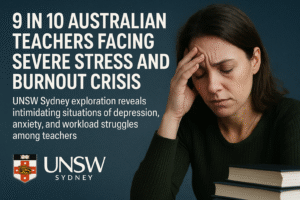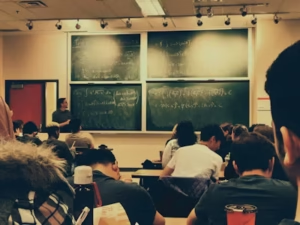9 in 10 Australian Teachers Facing Severe Stress and Burnout Crisis – UNSW Sydney Research Australian Teachers Stress

Australia’s education system is in the middle of a severe teacher stress and burnout crisis. According to a landmark study by researchers at UNSW Sydney, nearly nine out of ten teachers are struggling with extreme stress, while almost 70% admit their workload is impossible to manage.

The study, which surveyed more than 4,900 teachers nationwide, paints a deeply concerning picture of the profession. Mental health challenges such as depression, anxiety, and burnout are hitting teachers at three to four times the national average, forcing many to reconsider their careers.
Experts warn that unless urgent action is taken, the growing teacher shortage will only worsen, directly harming student outcomes.
Teachers’ Mental Health Under Pressure Australian Teachers Stress

The research, published in Social Psychology of Education, is the first large-scale investigation into the mental health of Australian teachers.
Using standardized psychological assessments, the study found that teachers’ depression, anxiety, and stress levels sit in the “extremely severe” range compared to the general population.
http://www.openday.unsw.edu.au
90% of teachers reported moderate to extreme stress. Australian Teachers Stress

More than two-thirds experienced moderate to severe depression and anxiety.
Stress scores were nearly four times higher than the national average.
Helena Granziera, lead researcher from UNSW’s School of Education, emphasized that this is not just a workplace issue:
“This isn’t just a well-being concern — it’s a workforce crisis. Teachers are experiencing mental health symptoms at rates far above the general population, and this is closely tied to workload and their decision to leave the profession.”
The Root Cause – Unmanageable Workload Australian Teachers Stress

One of the strongest predictors of poor teacher mental health was the overwhelming workload pressure.
The study found that 68.8% of teachers felt crushed under unmanageable responsibilities, especially administrative tasks. While teachers enter the profession to inspire and educate, much of their time is now consumed by non-teaching duties such as:

1.Compliance paperwork
2.Excessive data collection
3.Reporting requirements
4.Other regulatory tasks

This heavy administrative burden leaves teachers with less time for lesson planning, student
engagement, and personal recovery. Over time, this fuels burnout and disillusionment, pushing
many to the breaking point.
Who Is Most Affected?
The study highlighted that not all teachers are affected equally. Certain groups face even greater risks:

Rural and remote teachers reported higher levels of depressive symptoms compared to those in urban schools.
Female teachers were more likely to report both depressive symptoms and intentions to leave the profession.

These findings mirror broader occupational health trends, where women and workers in isolated areas often face greater mental health challenges.
The Bigger Picture – Impact on Students

The mental health crisis among teachers is not just about them personally — it directly affects students.
Research consistently shows that poor teacher well-being leads to:
Lower classroom quality
Reduced student achievement
Declines in student mental health

As Dr. Granziera notes:
“Teachers’ mental health is intricately linked to students’ academic performance and emotional well-being. Supporting teachers is essential not only for their own health but also for the success of our education system.
What Needs to Change?
To address the teacher burnout crisis, the UNSW research team has proposed a multi-layered approach:

1. Policy Reforms
Governments must reduce unnecessary administrative work and streamline reporting processes, allowing teachers to focus on teaching and student support.
2. School-Level Monitoring

Schools should actively monitor teacher well-being and adjust workloads where possible. Leadership support is critical in spotting early signs of burnout.
3. Investment in Mental Health Programs
Tailored digital mental health platforms can provide teachers with flexible, self-paced support, ensuring that help is accessible regardless of location.
4. System-Wide Retention Strategies
Broader interventions are needed to retain experienced teachers, preventing further shortages and ensuring stable learning environments for students.
A Call for Urgent Action

The study, conducted between October 2022 and May 2024, with recruitment via the Black Dog Institute and teacher networks, is one of the most comprehensive examinations of teacher mental health ever conducted in Australia.
Its findings are clear: without intervention, the education workforce faces a deepening retention crisis, with burnout driving talented teachers away from classrooms.
Dr. Granziera concluded with a stark warning:
if we want to retain skilled teachers and guarantee high-quality education for future generations, we must urgently address the root causes of stress and declining mental health among teachers.
Conclusion

Australia’s teachers are at breaking point. With nearly nine out of ten struggling under severe stress and two-thirds battling depression and anxiety, the profession is shouldering a mental health burden far beyond national averages.
Supporting teachers must become a national priority — not only to protect their health but also to safeguard the future of students and the entire education system.



1 thought on “9 in 10 Australian Teachers Facing Severe Stress and Burnout Crisis – UNSW Sydney Research”